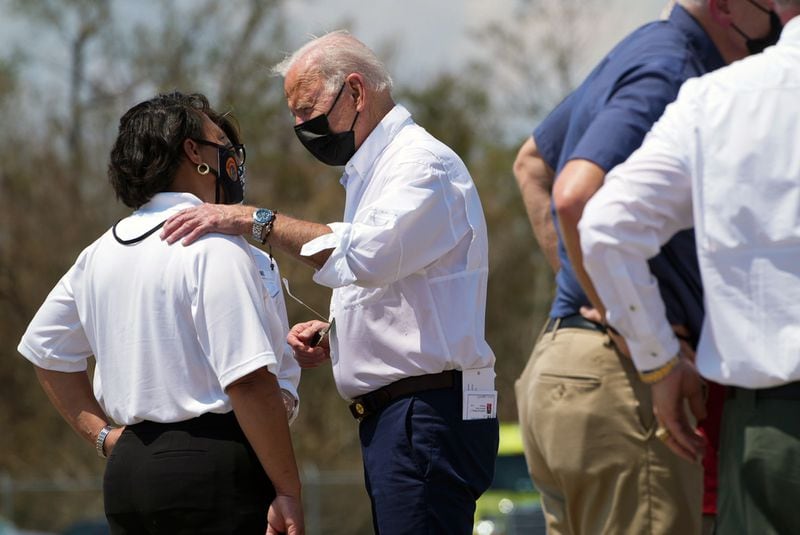NEW ORLEANS — Less than a week after Hurricane Ida ravaged the Gulf Coast, President Joe Biden was in Louisiana on Friday to get an up-close view of the damage and offer assistance from the federal government.
The devastation was clear as Air Force One approached New Orleans, with uprooted trees and blue tarps covering shredded houses coming into focus ahead of landing. The path to nearby LaPlace, where Biden was to be briefed by local officials, was dotted with wood poles that held power lines jutting from the ground at odd angles.
“I promise, we’re going to have your back,” Biden said at the outset of the briefing.
Such trips to natural disaster scenes have long been a feature of the U.S. presidency. It’s a moment to demonstrate compassion and show the public that the president is leading during the crisis. It’s also an opportunity to hit pause, however temporarily, from the political sniping that often dominates Washington.
In shirtsleeves and boots, Biden was welcomed at the airport by Louisiana Gov. John Bel Edwards, a Democrat. Several Republicans, including Sen. Bill Cassidy and Rep. Steve Scalise, the House Republican whip, were also on hand.
Biden was meeting with with local officials and touring a neighborhood in LaPlace, a community between the Mississippi River and Lake Pontchartrain that suffered catastrophic wind and water damage and was left with sheared-off roofs and flooded homes. He also planned a flyover tour of hard-hit communities including Lafitte, Grand Isle, Port Fourchon and Lafourche Parish, where Parish President Archie Chaisson said 25% of the homes in his community of 100,000 people were gone or had catastrophic damage.
Past presidents have been defined in part by how they handled such crises.
Donald Trump casually lobbed paper towels to people in Puerto Rico after a hurricane, generating scorn from critics but little damage to his political standing. Barack Obama hugged New Jersey Republican Gov. Chris Christie in 2012 after Superstorm Sandy, a brief respite from partisan tensions that had threatened the economy with a fiscal cliff. And George W. Bush fell out of public favor after a poor and unprepared response to Hurricane Katrina, which swamped New Orleans in 2005.
In the aftermath of Hurricane Ida, Biden is grappling with the persistent threat posed by climate change and the prospect that disaster zone visits may become a more regular feature of the presidency. Beyond the damage on the Gulf Coast, remnants from the storm killed at least 46 people from Maryland to Connecticut.
The president has pointed to that destruction to call for greater public resolve to confront climate change and help the nation deal with the fierce storms, flooding and wildfires that have beset the country.
Scientists say climate change increases the frequency of extreme weather events — such as large tropical storms, and the droughts and heatwaves that create conditions for vast wildfires. U.S. weather officials recently reported that July 2021 was the hottest month recorded in 142 years of record-keeping.
Biden’s nearly 8-month-old presidency has been shaped in part by perpetual crises. The president went to Texas in February after a cold winter storm caused its power grid to fail, and he has repeatedly monitored the wildfires that have darkened skies in Western states.
Besides natural disasters, the president has had to contend with a multitude of other challenges. He is searching for ways to rescue the 100 to 200 Americans stuck in Afghanistan after the longest war in U.S. history ended only a matter of days ago. He is also confronting the delta variant of the coronavirus that has stuck the country in an autumn of uncertainty only months after Biden declared independence from the disease at a July 4 celebration on the White House lawn.
About the Author






